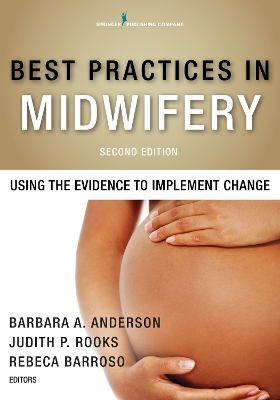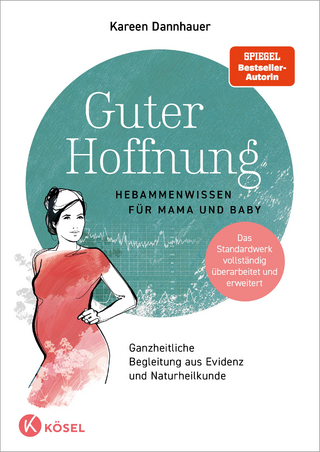
Best Practices in Midwifery
Springer Publishing Co Inc (Verlag)
978-0-8261-3178-2 (ISBN)
This second edition of a groundbreaking book is substantially revised to deliver the foundation for an evidence-based model for best practices in midwifery, a model critical to raising the United States' current standing as the bottom-ranking country for maternity mortality among developed nations.With a focus on updated scientific evidence as the framework for midwifery practice, the book includes 21 completely new chapters that address bothcontinuing and new areas of practice, the impact of institutional and national policies, and the effects of diversity and globalization. Incorporating themidwifery model of care, the book provides strategies for change and guidance for implementing evidence-based best practices.
The book examines midwifery efforts to improve the health of women and children in the U.S., for example, Strong Start, US MERA, Centering Pregnancy, a focus on physiologic birth, and successful global endeavors. It encompasses a diverse nationwide authorship that includes leaders in midwifery,academicians, midwives representing diversity, hospital- and community-based practitioners, and policymakers. This coalition of authors from diversebackgrounds facilitates an engaging and robust discussion around best practices. Chapters open with a contemporary review of the literature, a comparisonof current (often scientifically unsubstantiated and ineffective) practices, evidence-based recommendations, and best practices for midwifery.
Key Features:
Focuses on scientific evidence as the framework for midwifery practice
Addresses continuing and new, controversial areas of practice with strategies and guidelines for change
Includes 20 out of 27 completely new chapters
Authored by a diverse group of 44 prominent midwifery leaders
Examines practices that are in conflict with scientific evidence
Barbara A. Anderson, DrPH, CNM, FACNM, FAAN, has had a long career in nursing and public health, field-based teaching, mentorship, program planning, curriculum development, and academic administration. Judith P. Rooks, MPH, MS, CNM, FACNM, is past president of the American College of Nurse-Midwives. As a nurse-midwife and epidemiologist, she has had many years of service with the Centers for Disease Control and Prevention. Although retired, she continues to work on behalf of mothers, babies, and midwives. Rebeca Barroso, DNP, MSN, CNM, FACNM, is an assistant professor of midwifery at Frontier Nursing University and practices full-scope midwifery at HealthEast Care, Saint Paul, Minnesota, serving low-income national and international clientele at Seton Catholic Charities Clinic.
CONTENTS
Contributors
Foreword Holly Powell Kennedy, PhD, CNM, FACNM, FAAN
Preface
SECTION I: ADVANCING MIDWIFERY CARE
Barbara A. Anderson
1. The Midwifery Workforce: Issues Globally and in the United States
Judith T. Fullerton and Barbara A. Anderson
2. Advocating for Childbearing Women: Current Initiatives and Workforce Challenges
Heather M. Bradford and Jesse S. Bushman
3. Evaluating and Using Scientific Evidence: Foundation for Implementing Change
Billie Anne Gebb, Zach G. Young, and Barbara A. Anderson
SECTION II: MIDWIFERY CARE: THE EVIDENCE FOR OPTIMAL OUTCOMES
Rebeca Barroso
4. Facilitating Access to Midwifery-Led Prenatal and Postpartum Care
Julia C. Phillippi and Melody J. Castillo
5. Nutrition and Epigenetics in Pregnancy
Mary K. Barger
6. Evidence-Based Midwifery Care for Obese Childbearing Women
Laura A. Aughinbaugh and Nicole S. Carlson
7. Weight Management Counseling With Overweight and Obese Pregnant Women
Cecilia M. Jevitt
8. Maternal Concerns and Knowledge About Vaccination During Pregnancy: Counseling Childbearing Women
Deborah M. Brickner
9. Women in Migration: Best Practices in Midwifery
Jane M. Dyer
10. Racial and Ethnic Disparities in Birth Outcomes: The Challenge to Midwifery
Patricia O. Loftman
11. Circles of Change: CenteringPregnancy®, Health Disparities, and Vulnerable Women
Margaret S. Hutchison and Melanie R. Thomas
12. Postpartum Mood and Anxiety Disorders: Maximizing Midwifery Care
Cheryl Tatano Beck
13. Mind–Body Practices: Integration in the Midwifery Model of Care
Kathleen A. Moriarty
14. The Freestanding Birth Center: Evidence for Change in the Delivery of Health Care to Childbearing Families
Susan E. Stone, Eunice K. M. Ernst, and Susan R. Stapleton
15. Creating a Birth Center: Entrepreneurial Midwifery
Kathryn Schrag and Barbara A. Anderson
16. Home as the Place of Birth: The Evidence for Safety
Judith P. Rooks and Suzan Ulrich
SECTION III: THE INTRAPARTAL PERIOD: USING THE EVIDENCE
Rebeca Barroso
17. Therapeutic Presence and Continuous Labor Support: Hallmarks of Midwifery
Robin G. Jordan
18. Untethering in Labor: Using the Evidence for Best Practice
Susan M. Yount, Meghan Garland, and Rebeca Barroso
19. Vaginal Birth After Cesarean: Emotion and Reason
Mayri Sagady Leslie
20. The Limits of Choice: Elective Induction and Cesarean Delivery on Maternal Request
Kerri D. Schuiling and Joan K. Slager
21. Evidence-Based Management of Prelabor Rupture of the Membranes at Term
Amy Marowitz
22. The Midwife as Catalyst: Promoting Institutional Change With Intrapartum Immersion Hydrotherapy
Elizabeth Nutter and Jenna Shaw-Battista
23. Nitrous Oxide’s Place in Labor and Birth
Michelle R. Collins and Judith P. Rooks
24. Management of the Third Stage of Labor: Implementing Best Practices
Mavis N. Schorn
SECTION IV: COLLABORATIVE PRACTICE: THE EVIDENCE FOR BEST PRACTICES
Barbara A. Anderson
25. The Role of Midwifery in Mobilizing Communities to Improve Maternal and Newborn Health Outcomes
Jody R. Lori
26. The Evidence for Interprofessional Education in Midwifery
Denise Colter Smith and Mary Paul Backman
27. Creating a Collaborative Working Environment
Ginger K. Breedlove and John C. Jennings
28. Conclusion: Policy and Advocacy—Fostering Best Practices in a Dynamic Health Care Environment
Lisa Summers
Index
| Erscheinungsdatum | 07.09.2016 |
|---|---|
| Verlagsort | New York |
| Sprache | englisch |
| Maße | 178 x 254 mm |
| Themenwelt | Sachbuch/Ratgeber ► Gesundheit / Leben / Psychologie ► Schwangerschaft / Geburt |
| Medizin / Pharmazie ► Gesundheitsfachberufe ► Hebamme / Entbindungspfleger | |
| Medizin / Pharmazie ► Medizinische Fachgebiete ► Gynäkologie / Geburtshilfe | |
| Medizin / Pharmazie ► Medizinische Fachgebiete ► Pädiatrie | |
| ISBN-10 | 0-8261-3178-6 / 0826131786 |
| ISBN-13 | 978-0-8261-3178-2 / 9780826131782 |
| Zustand | Neuware |
| Haben Sie eine Frage zum Produkt? |
aus dem Bereich


